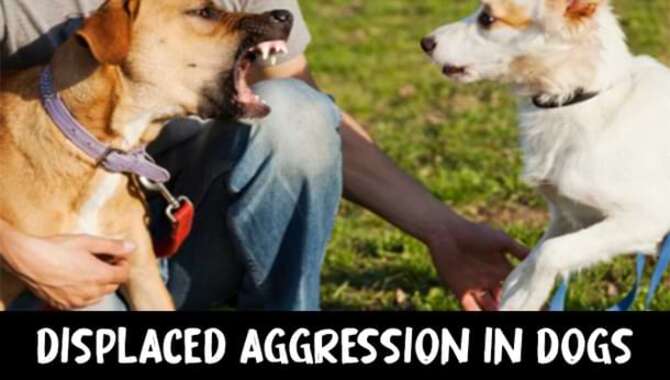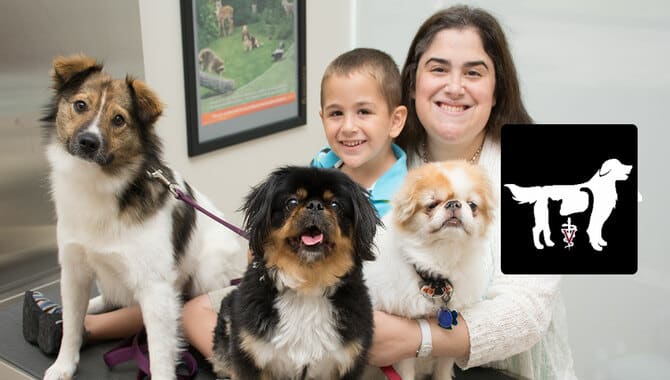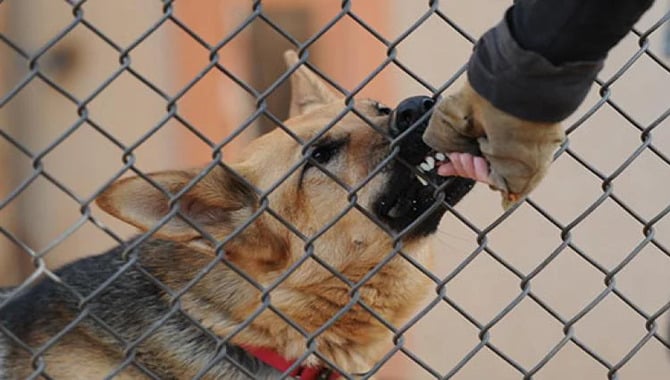Displaced aggression is the aggression of a dog that may or may not occur for a specific event. My friend had a dog with whom I would occasionally go for a walk. So what should you do if you see displaced aggression in dogs? The dog would normally walk and play with me.
But when he saw other dogs, he did not like to play with them. It could be seen jumping on another dog for no reason, even on a stranger. As a result, no one liked the dog and did not want to come near him. There are many dogs that can’t stand other dogs but jump on them without provocation. This aggression makes everyone afraid of the dog, and that becomes very painful for the dog and its owner. The dog has no idea how to control aggression. As a result, it became a disliked animal to many.

What Causes Dogs Aggression?
Dogs usually have a reason to be aggressive. A dog may have a painful past behind the cause-and-effect aggression. Displaced aggression is more common in dogs that are abused and neglected. Wounded and abused dogs cannot adapt everywhere. As a result, this behavior is more common among them when they see an unfamiliar object or person. Displaced aggression can occur in a dog when it finds no recognition between an object and a person.
Many people think that displaced aggression is usually done for revenge. But I don’t think so because the dog is an innocent animal and has no tendency to retaliate. However, I would say that displaced aggression should be addressed before it grows into a mild form.
It has been observed many times that the dog behaves aggressively due to his frustration that he will attack his owner, which is awful! Usually, when a dog grows up in a neglected and frustrated way, it behaves like this when it sees an unknown object or person. As a result, dogs react very quickly to threats and cannot control themselves.
But when you realize that your dog can behave with displaced aggression, you need to take some steps:
- Something that could cause frustration in him needs to be stopped.
- Teach the dog how to deal with depression without resorting to violence.
- Praise and caress him at that moment.
- Make him feel that he has no fear that you are by his side.
Compulsive Disorders And Displacement Behaviors

Compulsive disorders are common in dogs, especially those that have suffered abuse or neglect. These disorders may include the following:
- Anxiety is the most common of these and is caused when a dog feels a sense of helplessness and anxiety. Reactions to stressful events or situations can cause this. Some dogs will simply walk from place to place because they feel like that is all they can do then.
- Obsessive-Compulsive Disorder (OCD) – This is not just limited to humans. It can also be found in dogs. OCD is a disorder that causes the dog to repeat a behavior over and over again, usually in response to a thought or obsession.
- Stress-induced Hyperactivity – Dogs will have an increased level of energy when their body has been notified of stress, anxiety, or fear.
- Attention-seeking behavior – when a dog wants its owners‘ attention, they will act in this way.
- Territorial Aggression – This is when a dog will get angry and protective of his space.
Fear – Many things can trigger this, but most of the time, it is a fear of being left alone or fear of stranger
How To Deal With Displaced Aggression In Dogs?

If your dog behaves like displaced aggression, it needs to be addressed quickly. Otherwise, as your dog gets older, his weird behavior will increase. This will make your dog unpleasant to everyone, even to you. Because everyone is afraid of displaced aggression dogs, and no one wants to caress, which will make your dog more frustrated. So how do you deal with your dog’s displaced aggression behavior?
Redirected Aggression and Barrier Frustration
Many dogs will react when they see other animals, people, or objects that they consider to be a barrier to their comfort zone. This is what we call “Redirected Aggression.” It is a reaction by the dog that tries to protect himself from his frustration. It is a defense mechanism, and it is very common in dogs that have suffered from some sort of abuse.
One of the most obvious ways to see this behavior is when your dog growls at you when you try to take his food away from him. Dogs will also become aggressive against human family members as they reach maturity due to frustration. This may include jumping on people, biting, barking, and lunging against the person’s legs.
Examples of Redirected Aggression
When another dog, individual, or event frustrates a dog, the dog’s anger can be turned in a different direction. However, it is unable to focus its rage on the stimuli. Example: While standing near a window, your dog notices another dog outside.
Here is another example of Redirected Aggression in a dog. We see this all the time when a dog is being walked by its owner. The dog starts to act aggressively toward other people that are in their immediate area, usually other dogs who do not get along with the person’s dog. If the owner does not intervene and redirect the behavior, it will escalate and become more aggressive.
Stop Frustration Before It Starts

If you are the owner of a dog that seems to be hating his life and showing signs of frustration, look at what may be upsetting him. It may be time to reevaluate the treatment you have been giving him. If he is not getting enough exercise, he may need more play time or exercise differently.
Some dogs do not like to be told that they have to sleep, so they will find an outlet for barking by sleeping instead. They will not be satisfied until their owner forces them to get some exercise. It is better if you are there for your dog when he needs it rather than taking your anger out as he tries to tell you that he is frustrated.
Find Out The Cause Of Frustration
To find out the cause of frustration, first, you need to monitor your dog carefully and notice all the behaviors. This allows you to easily find your dog’s frustration trigger. When you notice a change in his behavior, make a note of it one by one. When you find out why your dog is barking, you can easily find a solution.
- If you notice that your dog is barking at another dog, always try to keep the dog away from the other dog. If your dog is out for a walk and you see another dog, start walking in the opposite direction.
- Avoid ringing the doorbell if your dog becomes aggressive after hearing the doorbell.
- If your dog behaves aggressively by looking at another dog through the window, use a window curtain.
- Walk with a little dog.
- Keep away from objects that make your dog behave aggressively.
The reason for doing this is to let your dog learn how to deal with depression. When he learns to deal with depression, he will no longer see displaced aggression.
Identify Frustration Triggers
Frustration is a feeling that many people experience. It is not uncommon for dogs to experience their own frustration, though they often vocalize it differently than humans. Here is how you can identify the frustration triggers in dogs-
- Snapping – Snapping is when a dog uses a quick, quick-snap, quick-snap, or a short snarl to communicate that he is feeling frustrated.
- Barking – This could be seen as a signal that the dog needs help, but sometimes it may also be an indicator of frustration.
- Grunting – This is more common in males and may occur during play with their owners. This noise may be a sign that the dog is pouting about things such as being left home alone, not being allowed to play with a toy, or getting affection from their owner.
- Low-pitch barking – This is a very low-pitched bark that an owner would hardly hear. The dog emits this sound when they are feeling frustrated.
- Showing Teeth – While this is a very normal canine response, dogs do it more often when they are feeling frustrated.
Take The Help Of A Professional
Although your dog is behaving abnormally out of frustration, if he or she harms someone for any reason, such as an animal or a human, you should take him or her to a professional. A professional will advise you on how your dog will deal with depression and behave normally.
Final Thought
Every dog has a specific reason behind displaced aggression. So you must identify the reason behind your dog’s behavior. When you can identify it, you can solve it very easily.
And I know your dog is definitely a favorite of your life. I hope my article about “Displaced Aggression In Dogs” has complimented you. Stay with us, and thank you!
FAQs
[rank_math_rich_snippet id=”s-f4573c61-1d86-43fa-a65a-a4b4f9674a84″]